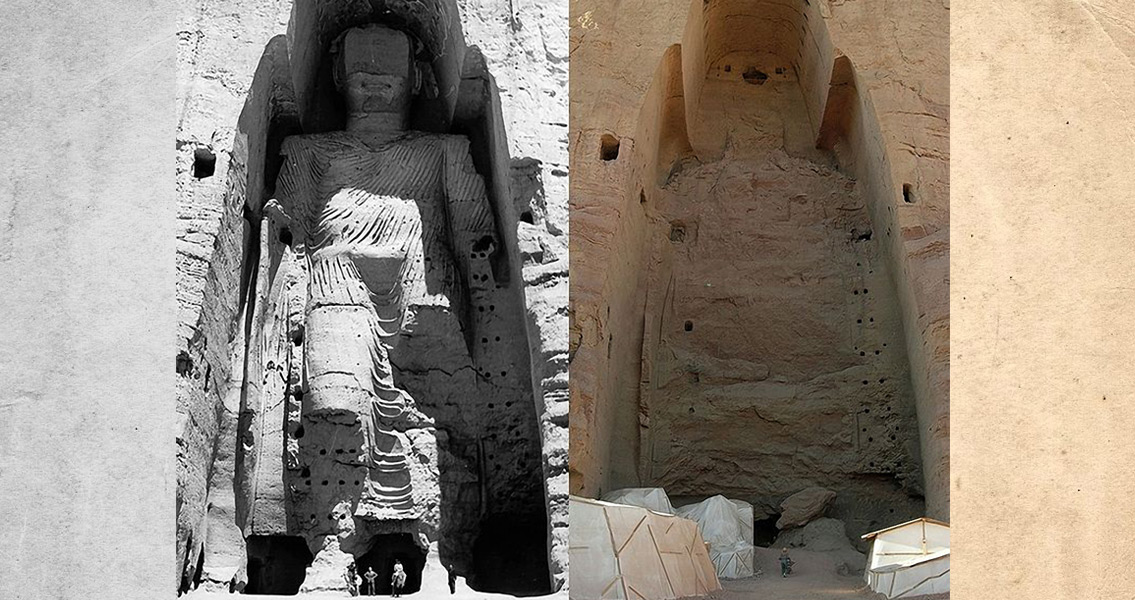<![CDATA[The huge cavities in the cliff close to the town of Bamiyan are one of the most astounding sites in Afghanistan. Sitting between two massive mountain ranges, the cavities are all that is left from a pair of giant Buddha statues which were destroyed by the Taliban in 2001. Reconstruction work is yet to commence on these giant figures however, as disputes between archaeologists and Unesco policy makers have led to constant delays. In order to understand the root cause of the statue's destruction, it is necessary to revisit the year 2001, when the Taliban-led regime was at loggerheads with the international community. The destruction of the pair of colossal Buddha figures was a defiant gesture to the outside world of the Taliban's intention to obliterate all Pre-Islamic 'icons' within the country. The work to bring down the statues started in March 2001 and lasted several weeks. The two figures standing at 58 and 38 metres tall proved to be surprisingly resilient to the anti-aircraft guns which were first used to try and destroy them. On realising this would fail to bring down the two ancient statues, a group of engineers bored holes into the statue's heads and packed them with dynamite, while anti-tank mines were placed between the statues' feet. It has been fourteen years since then, but reconstruction work is still being delayed, despite the desire among much of the local community for the statues to be restored. The two cavities are a reminder of Afghanistan's tragic recent history. The country had a long Buddhist heritage, one which was left largely untouched when Muslims first started to settle in the area in the ninth century. The mystical giant statues had stood firm for fifteen centuries before their destruction, gazing down at passing trade caravans and war armies. Monks had traveled from as far as China to worship at the statues, while others meditated in a nearby cave. Today, the site enjoys a peaceful environment compared to the Taliban period, with children playing below the cliffs and archaeologists doing their work uninterrupted. In Bamiyan itself a reasonably liberal form of Islam is practiced with few women wearing burqas and the region boasting the highest proportion of women in education in Afghanistan. Hamid Jalya, head of historical monuments in Bamiyan province, told the Guardian that many locals had completely forgotten that the statues used to be Buddha figures, perhaps suggesting a desire to move on from the destruction of the Taliban period. The two statues are a powerful symbol for a variety of reasons, meaning they have political currency way beyond their archaeological value. This has led to a variety of academics from across the world, from Korea to Germany and Japan to France, quarreling over the fate of the statues, and preventing real progress being made towards their reconstruction. Beyond these disagreements, there exists a very real controversy about how best to honour the fallen Buddhas. Some want to maintain the status quo so that future generations can see the effects of the Taliban's domination of Afghanistan, making the cavities a permanent reminder of a dark and controversial time in the country's history. Others however, want to reconstruct the figures; to restore the unique archaeological site and attract tourism to the area. Another objection stems from the fact that the two Buddhas are not the only important archaeological sites in Bamiyan Valley. Sites such as the ruins of Shahr-e-Gholghola fortress, or the fortified town of Shahr-i-Zohak, are equally at risk, having been worn down by earthquakes and harsh weather. The question raised by many is why is so much attention being focused on the destroyed Buddha statues? A major challenge of reconstruction would be obtaining the original materials, which is a requirement put down by the Venice Charter; the international code of conduct for the preservation and restoration of ancient buildings. This would be incredibly difficult, considering less than a third of the fragments have been collected so far. In addition, many of the pieces that have already been recovered are actually from reconstruction works which took place in the 1970s, when the feet of the smaller Buddha were rebuilt using materials that were not from the original construction. That notwithstanding, the idea of at least reconstructing the smaller Buddha is popular, having been proposed by German archaeologists and welcomed by the locals. This is viewed by some as a viable compromise - repairing the smaller statue but leaving the cavity of the larger one as a reminder of the Taliban occupation. Bamiyan's recent history has been greatly affected by the Taliban regime in Afghanistan. The continuing debate over the fate of the two massive Buddha statues reveals that politics plays just as big a role in archaeology and restoration as it does in international relations. Image courtesy of Wikimedia commons user: Zaccarias ]]>
Controversy Over Bamiyan Buddhas
